Welcome to the world of patio gardeners, where small spaces are transformed into lush green paradises, perfect for urban dwellers. In our fast-paced urban lifestyles, finding a patch of green to call our own can be a challenge. However, with the rise of patio gardeners, even the tiniest outdoor spaces can be transformed into vibrant oases of nature.
These green thumbs have mastered the art of gardening in small spaces, and their creativity knows no bounds. From balconies to tiny patios, they have unlocked the potential of urban gardening, bringing nature closer to our everyday lives.
But what exactly are patio gardeners? They are passionate individuals who have embraced the idea of small space gardening and have turned it into an art form. They have cultivated a deep understanding of the challenges and benefits of gardening in limited outdoor areas.
So, whether you have a small balcony or a cozy patio, join me on this journey as we delve into the world of patio gardeners, exploring their techniques, ideas, and tips for transforming small spaces into green havens.
Key Takeaways:
- Patio gardeners are individuals who have mastered the art of gardening in small outdoor spaces.
- They bring nature closer to urban dwellers, transforming balconies and patios into lush green paradises.
- Small space gardening requires thoughtful plant selection, creative container gardening ideas, and proper planning for continuous harvest.
- Crop rotation and coordination with neighboring gardeners can help manage disease and pest issues in limited outdoor areas.
- Amy Pennington’s book, “Tiny Space Gardening,” offers valuable insights and tips for successful small space gardening.
The Art of Gardening on Patios
Patio gardeners have mastered the art of growing plants in limited outdoor spaces, utilizing innovative container gardening techniques that bring life to even the smallest of patios. With a little creativity and careful planning, you can transform your patio into a lush and vibrant garden oasis.
Container gardening is the key to success when gardening on patios. Not only does it allow you to work with limited space, but it also offers flexibility in terms of design and plant selection. You can use a variety of containers, such as pots, planters, hanging baskets, and even repurposed items like old buckets or pallets.
One popular idea for patio gardening is vertical gardening. This technique involves utilizing vertical space to grow plants, either by attaching them to walls or using specialized vertical gardening systems. Vertical gardens not only maximize space but also create a stunning visual display. Imagine a wall covered in cascading flowers or a vertical herb garden right outside your kitchen window.
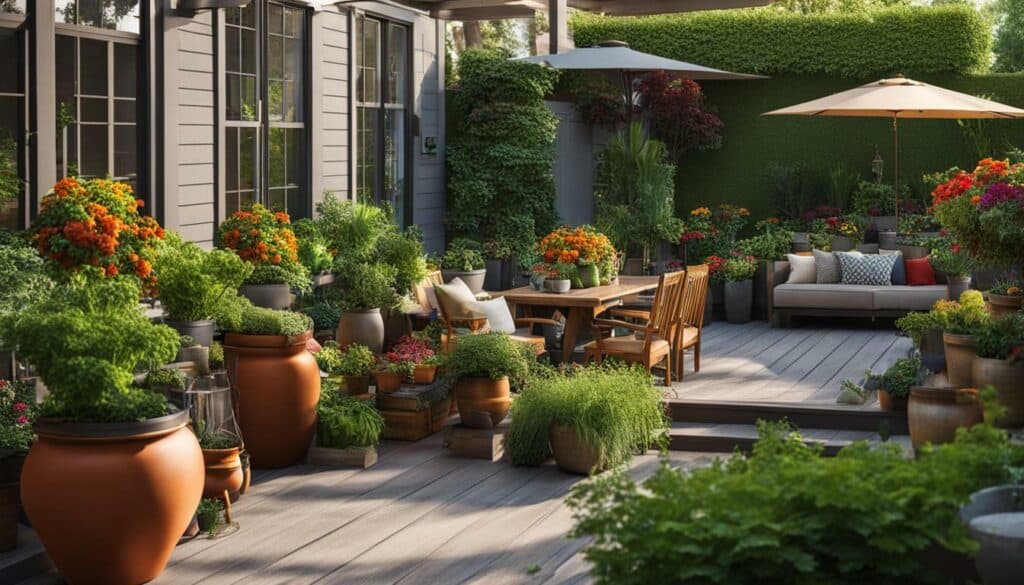
When it comes to patio gardening, the possibilities are endless. You can mix and match different plant varieties to create unique combinations. Consider incorporating a variety of colors, textures, and heights for visual interest. Additionally, don’t forget to experiment with different types of plants, including flowers, herbs, and even vegetables. Who says you can’t grow your own tomatoes or peppers on a small patio?
With container gardening, you can easily move your plants around to optimize sun exposure or change up the aesthetic of your patio space. It’s like having a portable garden that you can tailor to your preferences. So, get creative, experiment with different ideas, and enjoy the beauty and tranquility that a patio garden can bring to your small space.
Maximizing Small Spaces with Urban Gardening
Urban gardening has become a popular trend, allowing city dwellers to reconnect with nature by transforming their balconies into miniature gardens bursting with greenery. Whether you have a small balcony or a tiny patio, there are endless possibilities for creating a thriving urban garden. With a little creativity and careful planning, you can maximize every inch of your small space and enjoy the beauty and benefits of gardening.

When it comes to balcony gardening, choosing the right plants is crucial. Opt for compact varieties that don’t take up too much space but still offer a bountiful harvest. Herbs like basil, mint, and parsley are excellent choices, as they can be grown in small pots and used fresh in your favorite recipes.
Another great way to maximize small spaces is by utilizing vertical gardening techniques. Hanging baskets, wall-mounted planters, and trellises can all be used to create a vertical garden that adds visual interest and maximizes space. Consider growing climbing plants like tomatoes or cucumbers, which can be trained to grow vertically and save valuable ground space.
| Benefits of Balcony Gardening | Recommended Plants for Balcony Gardens |
|---|---|
|
|
“Gardening is a way to connect with nature and bring beauty into our everyday lives. Even in the smallest of spaces, we can create a thriving garden that brings joy and fresh produce.” – Amy Pennington, ‘Tiny Space Gardening’
With a little time and effort, you can transform your small balcony or patio into a vibrant oasis. Embrace urban gardening and make the most of your small space by incorporating these ideas and tips.
Designing Your Patio Garden
Designing a patio garden requires careful planning and consideration, as every inch of space must be maximized for both aesthetics and functionality. Whether you have a small balcony, a tiny courtyard, or a compact patio, there are various elements to consider for a successful patio garden design.
First, think about the overall layout of your space. Consider the dimensions and shape of your patio, as well as any existing features like walls, fences, or pillars. This will help you determine how to arrange your plants and other elements effectively. Creating a simple sketch or using a design tool can be helpful in visualizing different layouts.
Next, select the right plants for your patio garden. Choose plants that are suitable for your specific climate and light conditions. Consider the size and growth habit of each plant to ensure they won’t overcrowd the space. Opt for compact and dwarf varieties that won’t outgrow their containers or overshadow other plants.
| Plant | Sunlight Requirements | Container Size |
|---|---|---|
| Dwarf Roses | Full sun to partial shade | 12-inch pots |
| Herbs (Basil, Rosemary, Thyme) | Full sun | 6-inch pots |
| Succulents (Sedum, Echeveria) | Bright indirect light | 4-inch pots |
Don’t forget to incorporate functional elements into your patio garden as well. Consider adding seating areas, pathways, or even a small water feature to create a relaxing and inviting atmosphere. These elements not only enhance the overall design but also make your patio garden a practical and enjoyable space to spend time in.
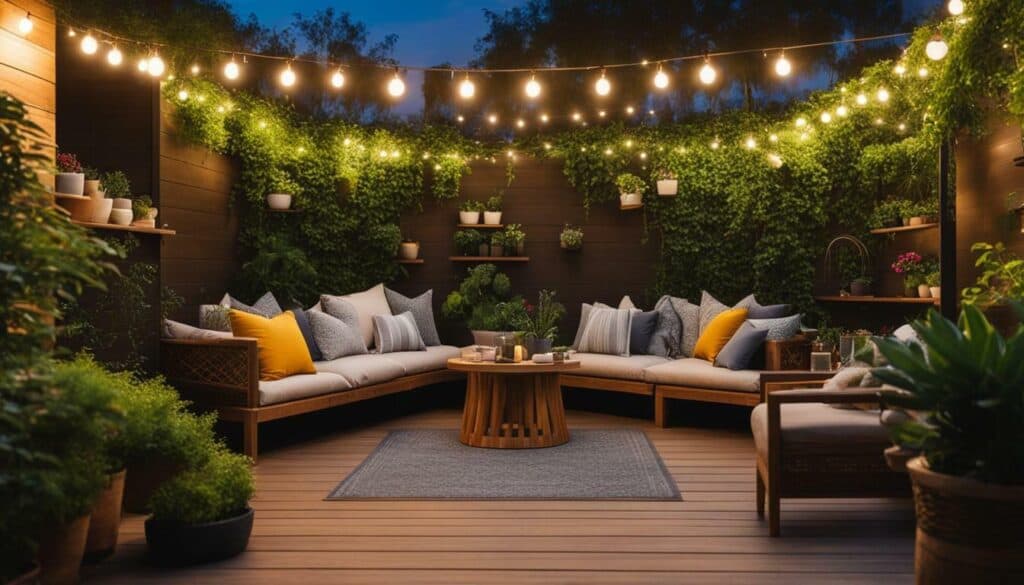
Remember, designing a patio garden is all about finding the right balance between aesthetics and functionality. By carefully selecting plants, arranging them thoughtfully, and incorporating functional elements, you can create a beautiful and productive oasis in your small outdoor space.
Choosing the Right Plants for Your Patio
Selecting the right plants is crucial for a successful patio garden, and choosing compact varieties that flourish in containers is key to maximizing space. When it comes to patio garden plants, there are plenty of options to suit different tastes and preferences. Here are some recommendations for plants that thrive in small outdoor spaces:
- Flowering plants: Brighten up your patio with colorful blooms. Some popular choices include petunias, geraniums, and marigolds.
- Herbs: Grow your own fresh herbs for cooking by planting basil, parsley, mint, or thyme in containers. They not only provide culinary flavors but also add a lovely fragrance to your outdoor space.
- Vegetables: Yes, you can grow vegetables in containers! Try patio-friendly varieties such as cherry tomatoes, compact peppers, and bush beans. They are ideal for small-space gardening and still yield a bountiful harvest.
- Fruits: If you have a sunny patio, consider growing small fruit trees like dwarf apple or citrus varieties. Strawberries and blueberries also do well in containers and provide a delicious harvest.
Remember to provide the right conditions for your patio garden plants. Ensure they receive adequate sunlight and water according to their specific needs. Patio vegetables, for example, may require more frequent watering than flowering plants. Regularly check the soil moisture and adjust your watering schedule accordingly. It’s also a good idea to fertilize your plants with a balanced organic fertilizer to promote healthy growth.

Incorporating a variety of plants in your patio garden not only adds beauty but also attracts beneficial insects and pollinators. This helps to create a balanced ecosystem and increases the chances of a successful harvest. Experiment with different combinations of plants and use vertical gardening techniques to make the most of limited space.
Table: Recommended Patio Garden Plants
| Plant Type | Examples |
|---|---|
| Flowering plants | Petunias, geraniums, marigolds |
| Herbs | Basil, parsley, mint, thyme |
| Vegetables | Cherry tomatoes, compact peppers, bush beans |
| Fruits | Dwarf apple trees, citrus trees, strawberries, blueberries |
With the right plant choices and proper care, your patio garden can become a thriving oasis in the midst of your urban surroundings. So, start planning your small space garden and enjoy the rewards of fresh produce and natural beauty right outside your door!
Tips for Successful Small Space Gardening
Successful small space gardening requires attention to detail and implementing smart strategies to ensure that plants thrive in their limited environment. Here are some tips to help you make the most of your small outdoor space:
- Choose the right plants: Opt for compact varieties of plants that don’t take up too much space. Look for plants that are specifically bred for container gardening, such as dwarf tomatoes, miniature peppers, and compact herbs.
- Maximize vertical space: Utilize wall-mounted planters, hanging baskets, and trellises to grow plants vertically. This will free up valuable floor space and allow you to cultivate a greater variety of plants.
- Provide adequate sunlight: Most plants require at least six hours of direct sunlight each day. Ensure that your small space receives enough sunlight by placing your containers in the sunniest areas of your patio or balcony.
- Proper watering: Container plants often need to be watered more frequently than those planted in the ground. Check the moisture level of the soil regularly and water as needed, making sure not to overwater or underwater your plants.
- Implement companion planting: Some plants grow better when planted together, while others benefit from the natural pest-repelling properties of certain companion plants. Research companion planting techniques to optimize the health and productivity of your small space garden.
With these tips in mind, you can create a thriving garden in even the smallest of spaces. Remember to experiment, adapt, and enjoy the process of growing plants in your unique outdoor environment.
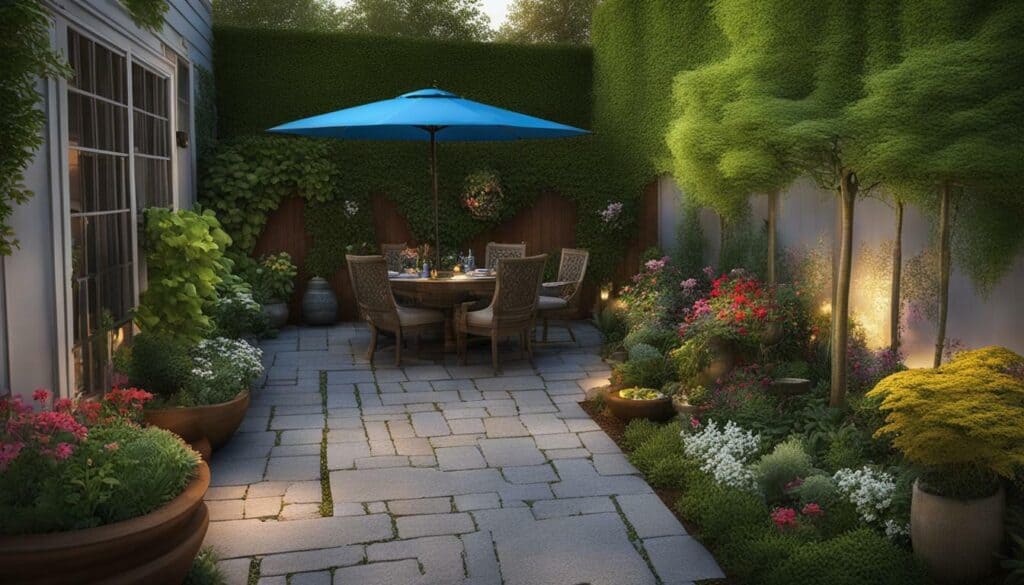
“In small space gardening, it’s all about being creative with the limited space you have. Don’t be afraid to think outside the box and try new techniques like vertical gardening or companion planting. With a little ingenuity, you can transform your small patio or balcony into a lush and productive garden.” – Amy Pennington, author of Tiny Space Gardening
| Plant | Space requirements |
|---|---|
| Tomatoes | Determinate varieties are best for containers |
| Peppers | Compact varieties are ideal for small spaces |
| Herbs | Grow well in small pots or hanging baskets |
| Lettuce | Leaf lettuce is perfect for window boxes or shallow containers |
Succession Planting for Continuous Harvest
Succession planting is the secret weapon of patio gardeners, allowing them to enjoy a continuous supply of fresh produce from their limited garden space. By carefully planning and timing their plantings, patio gardeners can ensure that there is always something ready to harvest, providing a steady stream of homegrown goodness throughout the growing season.
One popular method of succession planting is to sow seeds or transplant young seedlings at regular intervals. This staggered approach to planting ensures that crops mature at different times, allowing for a continuous harvest. For example, you can plant a row of lettuce seeds, and once they have sprouted and started growing, you can plant another row. By the time the first row is ready to be harvested, the second row will be reaching maturity, providing a seamless transition of fresh greens.
Another technique is to take advantage of plants that have a short harvesting window. For instance, radishes and baby carrots can be sown every couple of weeks, ensuring a constant supply of these quick-growing root vegetables. Additionally, you can interplant fast-maturing crops like salad greens or herbs between slower-growing plants. This way, you can harvest the quick crops while you wait for the others to reach maturity.
By incorporating succession planting into your patio garden, you can make the most of your limited space and ensure you have a bountiful harvest throughout the season. Whether you’re growing vegetables, herbs, or flowers, this technique will keep your garden productive and vibrant.
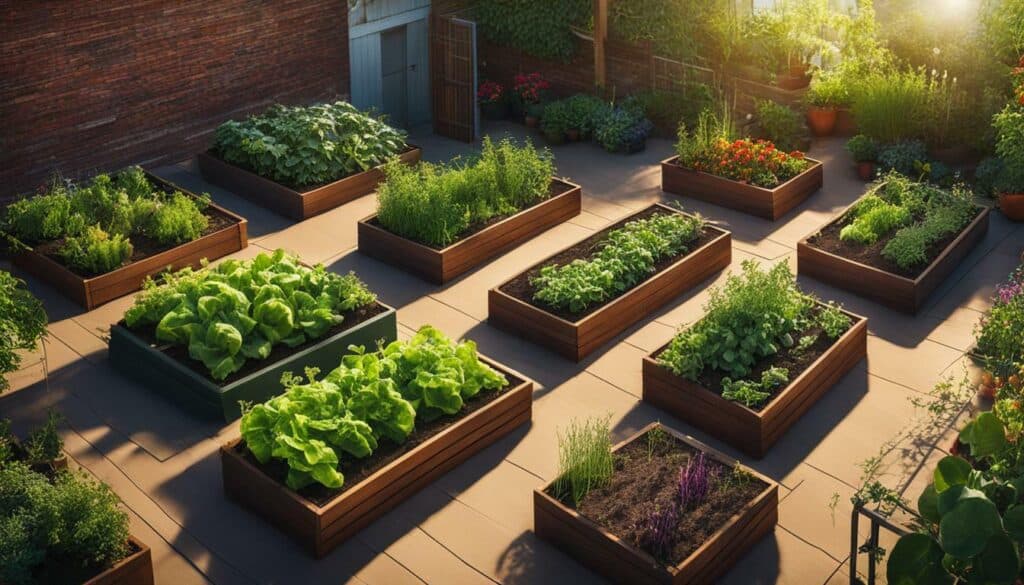
| Vegetables | Ideal Succession Planting Interval |
|---|---|
| Lettuce | Every 2-3 weeks |
| Radishes | Every 2 weeks |
| Beans | Every 2-3 weeks |
| Spinach | Every 3-4 weeks |
| Cucumbers | Every 3-4 weeks |
Remember to consider the specific requirements of each plant, such as sun exposure and soil fertility, when planning your succession planting schedule. This will help you optimize your garden space and ensure a successful and abundant harvest throughout the season.
Managing Disease and Pest Issues
Disease and pests can be a challenge in small space gardening, but with proper crop rotation techniques, patio gardeners can minimize these issues and maintain a healthy garden. Crop rotation involves changing the location of plants within your garden each year to disrupt the life cycles of pests and pathogens. By rotating crops, you can reduce the likelihood of diseases building up in the soil and deter pests that may be attracted to specific plants.
To implement crop rotation in small spaces, you can create raised beds or coordinate with neighboring gardeners to share planting areas. This allows you to alternate the types of crops grown in each bed or plot, preventing the buildup of pests and diseases that can harm your plants. By diversifying what you plant and where you plant it, you create an inhospitable environment for pests and diseases, promoting a healthier garden overall.
Another benefit of crop rotation is that it helps to maintain soil fertility. Different plants have different nutrient requirements, and rotating crops allows the soil to replenish and regain its balance. Furthermore, certain plants, such as legumes, can help fix nitrogen in the soil, benefiting future crops.
By practicing crop rotation and implementing other good gardening practices, such as proper watering and regular monitoring for pests and diseases, patio gardeners can enjoy a thriving and bountiful garden in their small spaces.
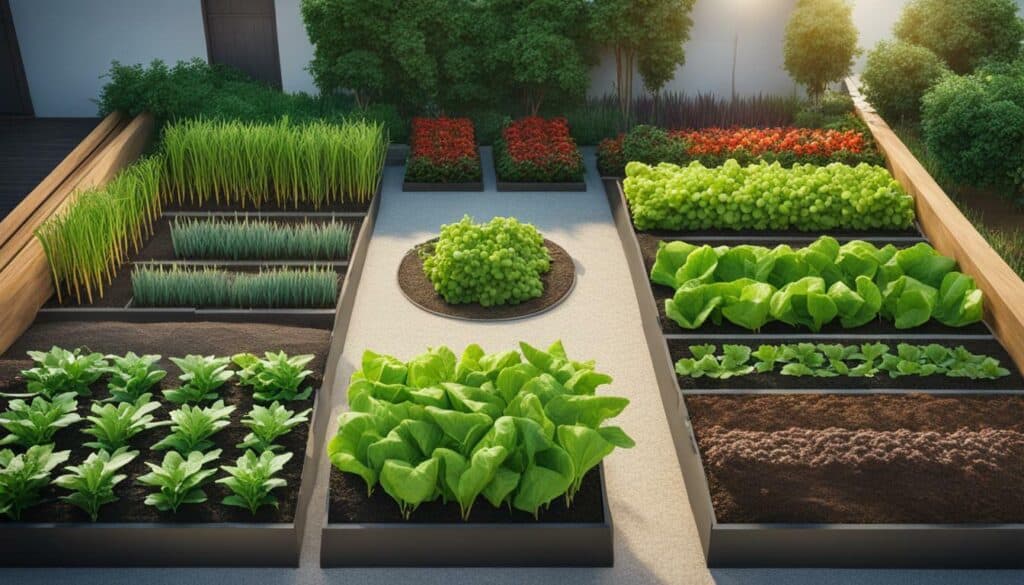
| Benefits of Crop Rotation in Small Space Gardening |
|---|
| 1. Minimizes pest and disease problems |
| 2. Promotes healthier soil |
| 3. Enhances overall garden productivity |
| 4. Enables efficient use of limited gardening space |
Recommendations from Amy Pennington’s Book: Tiny Space Gardening
Amy Pennington’s book, “Tiny Space Gardening,” is a must-read for patio gardeners, providing a wealth of knowledge and inspiration for transforming small outdoor spaces into productive gardens. With her expert guidance, even the tiniest of spaces can be turned into thriving green havens. Pennington covers a wide range of topics, including selecting the right plants, maximizing space, and managing common challenges. Her practical tips and creative ideas will empower readers to create beautiful and productive patio gardens.
One of the key takeaways from Pennington’s book is the importance of selecting the right plants for small space gardening. She recommends choosing compact varieties that don’t take up too much space but still yield abundant harvests. Her book offers an extensive list of fruits, vegetables, herbs, and flowers that are well-suited for patio gardens. From cherry tomatoes to dwarf citrus trees, Pennington provides options for every gardener’s taste and preferences.
In addition to plant selection, Pennington emphasizes the importance of maximizing space through creative techniques such as vertical gardening and the strategic use of pots and planters. She offers innovative ideas on how to arrange plants for visual appeal while ensuring functionality. Her book includes beautiful illustrations and photographs that showcase the potential of small space gardening, inspiring readers to think outside the box and experiment with different designs.
Pennington also addresses common problems faced by patio gardeners, such as watering, fertilizing, and pest management. She provides practical tips and techniques for addressing these challenges and maintaining healthy plants. The book even includes recipes that incorporate homegrown produce, demonstrating the rewards of small space gardening beyond aesthetics.
If you’re a patio gardener looking to make the most of your small outdoor space, “Tiny Space Gardening” by Amy Pennington is a valuable resource. Whether you’re a beginner or an experienced gardener, her book offers insights and inspiration that will help you cultivate a thriving garden in even the tiniest of spaces.
Book Details:
| Title: | Tiny Space Gardening |
|---|---|
| Author: | Amy Pennington |
| Publication Date: | July 10, 2018 |
| Publisher: | Ten Speed Press |
| Pages: | 192 |
| ISBN: | 978-0399579180 |
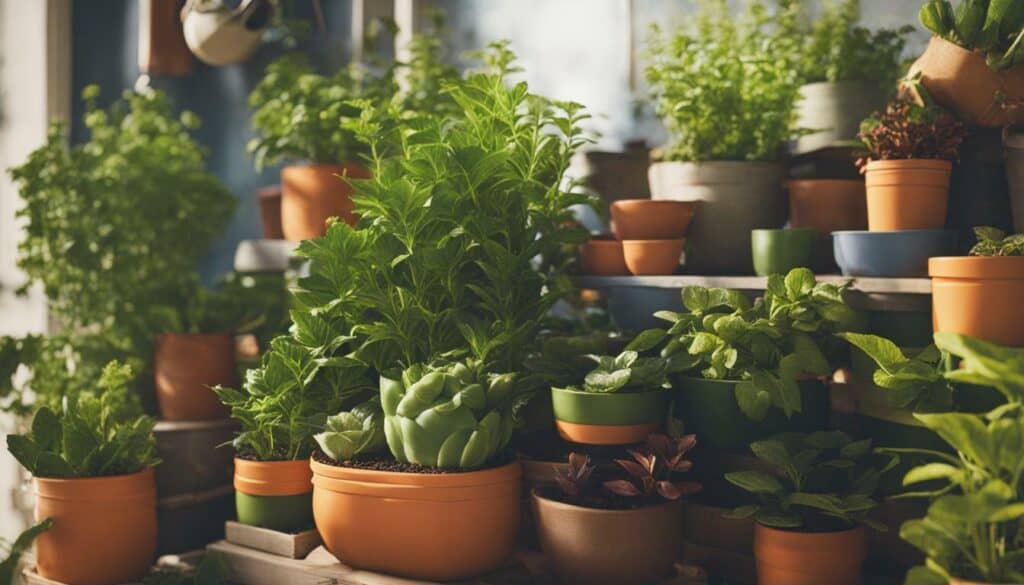
Patio gardeners play a crucial role in transforming small spaces into thriving oases, bringing nature into urban environments and allowing everyone to enjoy the joys of gardening, no matter how limited their space may be. It’s incredible to witness the creativity and ingenuity of these passionate individuals as they make the most of their patio areas to create beautiful and functional gardens.
Small space gardening requires careful planning and strategic plant choices. By opting for compact varieties and utilizing containers, patio gardeners can grow a wide range of plants, from vibrant flowers to delicious vegetables and herbs. With the right techniques, such as succession planting and crop rotation, they can ensure a continuous harvest throughout the season and manage potential disease and pest issues.
Urban gardening has its unique challenges, but it also presents countless opportunities for individuals to connect with nature and contribute to a greener environment. Balconies, rooftops, and tiny patios can all be transformed into lush green spaces that bring a sense of tranquility and joy to city dwellers. By embracing container gardening and maximizing limited spaces, urban gardeners are making a positive impact on their surroundings.
For those looking to delve deeper into the world of small space gardening, Amy Pennington’s book, “Tiny Space Gardening,” is an invaluable resource. Filled with practical tips, creative ideas, and delicious recipes, it provides inspiration and guidance for making the most of small outdoor spaces. From designing a patio garden to choosing the right plants, Amy’s expertise empowers gardeners to create their own miniature paradises, no matter where they live.
FAQ on What are Patio Gardeners
Q: What are patio gardeners?
A: Patio gardeners are individuals who transform small outdoor spaces, such as patios, balconies, and rooftops, into green havens by growing plants in containers.
Q: How do patio gardeners maximize small spaces?
A: Patio gardeners maximize small spaces by using techniques such as container gardening, vertical gardening, and creative use of pots and planters to grow a variety of plants.
Q: What plants are best for patio gardens?
A: Recommended plants for patio gardens include compact peppers, determinate tomatoes, herbs, annual flowers, and leaf lettuce. It’s important to choose compact varieties that don’t take up too much space.
Q: What is succession planting?
A: Succession planting is a technique where patio gardeners plan and time their plantings to have a continuous harvest throughout the growing season, ensuring a steady supply of fresh produce.
Q: How can I prevent disease and pest problems in my patio garden?
A: One way to prevent disease and pest problems is by practicing crop rotation. This can be done in small spaces by building raised beds or coordinating with neighboring gardeners.
Q: Are there any recommended resources for small space gardening?
A: Yes, Amy Pennington’s book “Tiny Space Gardening” is a valuable resource that provides helpful information, tips, recipes, and ideas for maximizing productivity in small outdoor spaces.

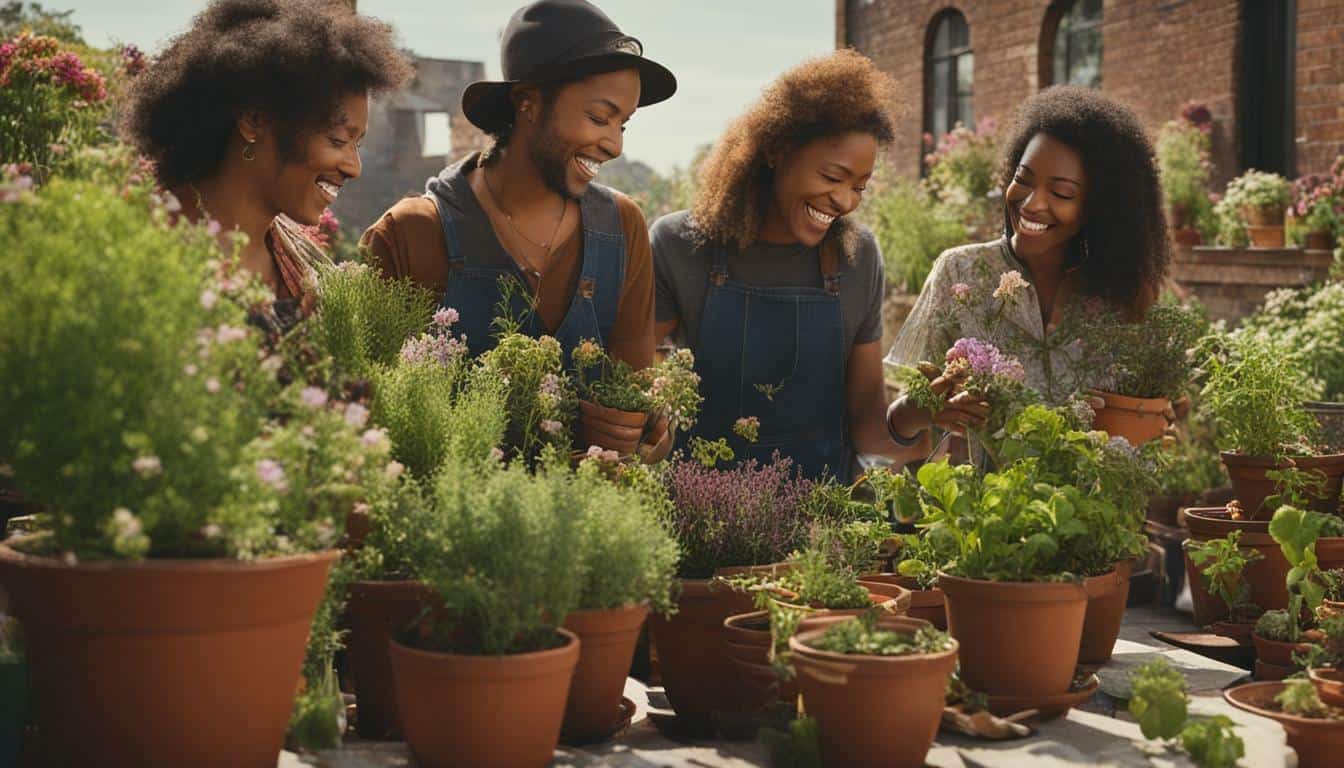



Leave a Reply